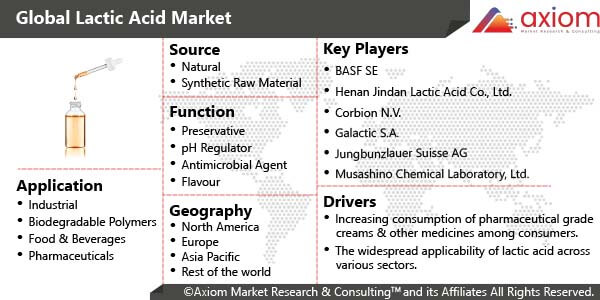Lactic acid is low molecular weight organic acid which is produced mainly by fermentation using lactic acid bacteria or synthetically. For many years this acid is used in many food and chemical industries with wide range of applications. Furthermore, lactic acid is also used in pharmaceutical and cosmetic industries based on its functional properties as. This alpha hydroxyl acid plays also several and major roles in many biochemical pathways. In addition, in recent years more attention was given to lactic acid based on its use to produce polylactic acid (PLA) which nowadays finds many industrial and medical applications as safe, biocompatible, and biodegradable polymer.
Lactic Acid Market Outlook
In recent years, the demand for lactic acid has increased considerably because of its use as a monomer in the preparation of polylactic acid (PLA), which is a biodegradable and biocompatible polymer that is used in a wide variety of applications. Its uses range from packaging and fibers to foams and applications in biomedical devices. The natural lactic acid segment exhibits immense scope for growth as a result of growing research and development activities focusing on various ways to derive lactic acid naturally in such a way as to scale it up to commercial production levels. Synthetic lactic acid is derived from depleting sources like coal and petroleum, which as a result of their depleting nature, are expected to become a more expensive source of raw material, hence driving production towards more cost-efficient and beneficial methods, in this case it would be the natural or fermentation method.
Lactic Acid Market Segmental Overview
The report analyses the global lactic acid market based on source, function, application and geography.
Lactic Acid Market by Source
The two methods of producing lactic acid are by using natural or synthetic raw material. Natural lactic acid uses raw materials available in nature which are a renewable resource. This segment exhibits immense scope for growth as a result of growing research and development activities focusing on various ways to derive lactic acid naturally in such a way as to scale it up to commercial production levels. The results of these activities are expected to bear fruit in the medium to long term, owing to the generally long gestation periods that that are characteristic of R&D initiatives.
Lactic Acid Market by Function
Lactic acid mainly used as preservative, PH regulator, antimicrobial agent, flavour and others. Among all these, its use as an anti-microbial agent is expected to grow the fastest CAGR in terms of volume and value respectively. This could be as a result of the research and development activities being carried out bearing fruit. Such activities, especially in the healthcare sector which is the major user of lactic acid as an anti-microbial agent, take time to reflect in the market in the form of better production and revenue.
Lactic Acid Market by Application
Major applications of lactic acid market are industrial, biodegradable polymers, food & beverages, pharmaceuticals, personal care and others. The applications of lactic acid in the biodegradable polymers and the food & beverages sector accounted for over 60% of the total global volume for the year 2018. This trend is expected to continue into the forecast years as well.
Lactic Acid Market by Geography
By geography, the global lactic acid market is studied across the countries of key regions such as, North America, Europe, Asia Pacific and rest of the world. The North America is the largest consumer of lactic acid holding the major market share in 2019, owing to its extensive use as an antimicrobial agent in meat, bakery products, also it is popular in food and beverages industry, and its use in packaging of food products where the biodegradable plastic are designed from polylactic acid based polymer etc. Followed by North America, Europe is expected to develop at a second highest CAGR during the forecast timeframe due to increasing industrial use of lactic acid wherein the UK region the rising environmental issues has made the government to take efforts for improvement of food packing material used in food industries.
Furthermore, the Asia Pacific is projected to be the fastest growing region globally attributing to widespread use of lactic acid in manufacturing of biopolymers, growing consumption of meat, poultry, fish etc., rising preference to packed food due to westernization, and changing lifestyle.
Lactic Acid Market Key Players
The major companies operating in the lactic acid market include BASF SE (Germany), Henan Jindan Lactic Acid Co., Ltd. (China), Corbion N.V. (Netherlands), Galactic S.A. (Belgium), Jungbunzlauer Suisse AG (Switzerland), Musashino Chemical Laboratory, Ltd. (Japan), NatureWorks LLC (United States), Synbra Technology BV (Netherlands), and Vaishnavi Bio-Tech Ltd. (India) among others. While all companies within this group have very high lactic acid revenues, there are also important differences between them, major companies such as Corbion N.V. and Galactic S.A have many products in their diverse portfolios, a relatively wide geographic spread. The key companies compete against each other based on factors such as innovations, price and quality of the product.











